Exploring the Pros and Cons of Customer Service Types

Customer service plays a vital role in shaping your business's success. It’s not just about solving problems; it’s about creating memorable experiences that keep customers coming back. Did you know a 5% increase in customer retention can boost profits by 25% to 95%? That’s the power of exceptional customer engagement. But here’s the catch: not all customers have the same needs. Some prefer the speed of live chat, while others value the professionalism of email or the personal touch of phone calls. Understanding the different types of customer service options ensures you’re meeting your customers where they feel most comfortable. Whether it’s through self-service portals, social media, or phone support, aligning your customer support strategy with their preferences can lead to higher customer satisfaction and loyalty. With solutions like Sobot, you can deliver seamless, personalized interactions across all customer service channels, enhancing customer experience at every touchpoint.
Live Chat Customer Service: Pros and Cons

Advantages of Live Chat Customer Service
Live chat support is one of the most popular customer service channels today, and for good reason. It offers faster response time compared to other types of customer service. On average, customers wait just 36 seconds to connect with an agent. This speed is a game-changer, especially when you’re dealing with urgent issues.
Another perk? Convenience. Live chat customer service lets you multitask while getting help. You don’t have to stay glued to your phone or email inbox. Plus, it’s available across devices, making it easy to access whether you’re at home or on the go.
Here’s a quick look at why live chat shines:
| Statistic | Value |
|-----------|-------|
| Average waiting time on live chat | 36 seconds |
| Percentage of consumers satisfied with live chat | 73% |
| Average customer satisfaction rating for live chat | 83.1% |
| Percentage of customers prioritizing quality support | 95% |
| Percentage of customers perceiving live chat as effective | 79% |
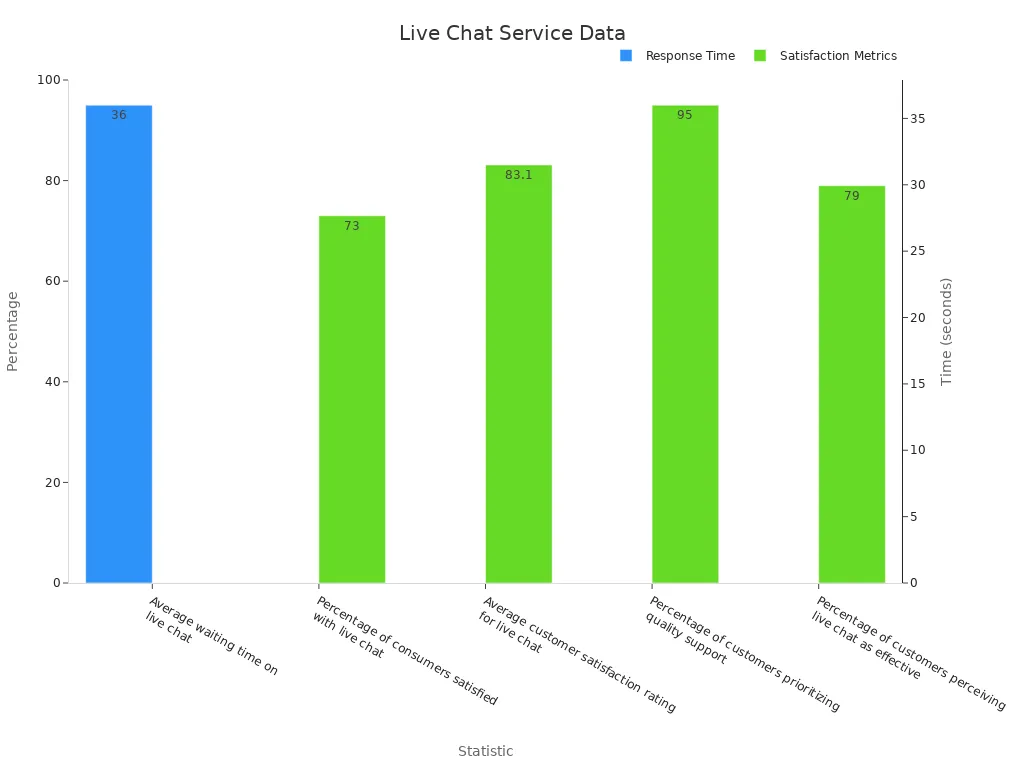
Live chat also boosts customer experience by offering 24/7 availability. Whether it’s midnight or midday, you can get the help you need without waiting for business hours.
Disadvantages of Live Chat Customer Service
While live chat support has its perks, it’s not perfect. One of the biggest disadvantages is the lack of personal touch. Some customers feel that chatting with an agent doesn’t offer the same connection as speaking over the phone.
Another challenge is handling complex issues. Live chat customer service works best for quick questions or troubleshooting. But when problems require detailed explanations, it can feel limiting.
Lastly, live chat relies heavily on technology. If the system crashes or experiences delays, it can frustrate customers. That’s why choosing a reliable platform is crucial.
How Sobot’s Live Chat Enhances Customer Interactions
Sobot’s live chat support takes customer experience to the next level. It combines speed, convenience, and intelligence to deliver seamless interactions. With Sobot, you get a unified inbox that consolidates messages from all customer service channels. This means no more switching between platforms to track conversations.
The AI-enhanced workspace is another standout feature. It uses automation to handle repetitive queries, freeing up agents to focus on complex issues. This improves efficiency and ensures customers get the help they need faster.
Sobot’s live chat also integrates customer data into the chat interface. Agents can see past interactions, preferences, and purchase history, allowing them to provide personalized support. And with multilingual capabilities, you can cater to a global audience effortlessly.
If you’re looking for a solution that combines speed, reliability, and personalization, Sobot’s live chat support is a great choice. Learn more about how Sobot can transform your customer support strategy here.
Email Customer Service: Pros and Cons
Benefits of Email Customer Service
Email support remains a cornerstone of customer service for many businesses. Why? It’s reliable, professional, and easy to use. You can send detailed explanations, attach files, and even include screenshots to clarify your concerns. This makes email customer service perfect for handling complex issues that require more than a quick response.
Another big advantage is its accessibility. You don’t need to wait on hold or stay online. You can send an email anytime and get back to it when it’s convenient for you. Plus, email creates a written record of your communication. This helps both you and the company track progress and avoid misunderstandings.
For businesses, email support offers scalability. A single agent can manage multiple conversations, making it cost-effective. With tools like Sobot’s ticketing system, you can automate workflows, manage SLAs, and ensure no email slips through the cracks.
Drawbacks of Email Customer Service
While email support has its strengths, it’s not without disadvantages. One common issue is delays. Unlike live chat or phone support, email responses can take hours—or even days—depending on the company’s workload. This can frustrate customers, especially during urgent situations.
Other challenges include lost communications and lack of updates. If emails go unanswered or get buried in a crowded inbox, customers may lose trust in the brand. Worse, unhappy customers might share their experiences publicly, damaging your reputation.
To avoid these pitfalls, it’s essential to use a robust system like Sobot’s ticketing platform. It ensures every email is tracked and prioritized, reducing the risk of delays or missed messages.
Best Practices for Email Support
Want to make your email support more effective? Start by setting clear expectations. Let customers know when they can expect a response. Aim for a 24-hour turnaround time or less.
Next, focus on clarity and professionalism. Use the 7C framework to craft emails that are clear, concise, and customer-focused. Personalize your responses by addressing customers by name and referencing their specific concerns.
Finally, measure your performance. Track metrics like open rates, response times, and resolution rates to identify areas for improvement. Tools like Sobot’s analytics can help you monitor these benchmarks and optimize your email support strategy.
Phone Customer Service: Pros and Cons
Strengths of Phone Customer Service
Phone customer support remains one of the most trusted types of customer service. Why? It offers a personal touch that other channels often lack. When customers hear a real voice on the other end, it builds trust and makes them feel valued. This is especially important for resolving urgent or complex issues.
Here’s a quick look at the metrics that highlight the strengths of phone customer service:
| Metric | Description |
|---|---|
| Average Handle Time | Measures the total time taken to resolve a customer query, indicating efficiency in handling issues. |
| SLA Adherence | Reflects how consistently the support team meets promised response and resolution times. |
| Backlog | Indicates the number of unresolved issues that exceed defined response times, highlighting workflow inefficiencies. |
| Customer Effort Score | Assesses how easy it is for customers to resolve their issues, impacting customer satisfaction and loyalty. |
| Resolution Rate | Tracks the percentage of successfully resolved tickets, indicating the effectiveness of the support team. |
When you need immediate answers, phone support delivers. It’s direct, fast, and effective for solving problems that require detailed explanations.
Limitations of Phone Customer Service
Despite its strengths, phone customer service has its disadvantages. Long wait times are a common frustration. Customers expect instant service, and delays can lead to dissatisfaction. In fact, 52% of customers stop purchasing from a brand due to long wait times.
Here’s a breakdown of some challenges:
| Evidence Description | Statistic |
|---|---|
| Increase in satisfaction when wait time is less than expected | 1.6 times |
| Percentage of customers who stop purchasing due to long wait times | 52% |
| Increase in dissatisfaction when wait times exceed expectations | 262% |
| Percentage of customers sharing bad experiences with others | 13% |
| Customers considering instant service crucial to their experience | 90% |
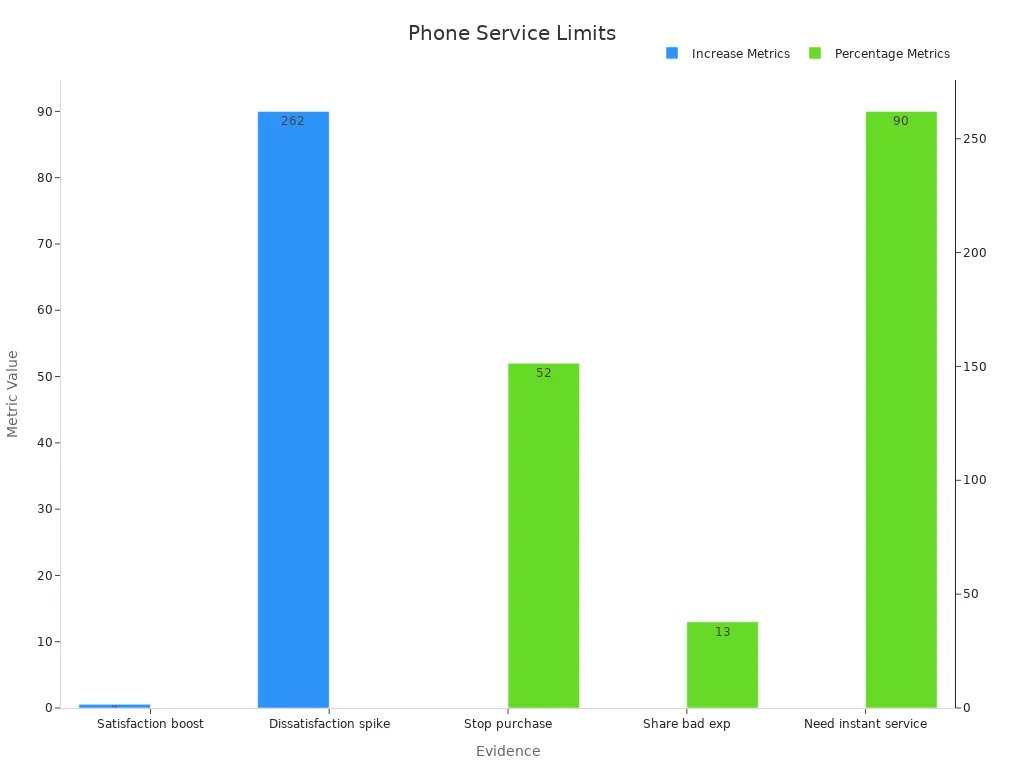
Another issue is cost. Maintaining a call center with trained agents and advanced technology can be expensive. Plus, if the system isn’t reliable, it can lead to a lack of customer focus, further damaging your brand’s reputation.
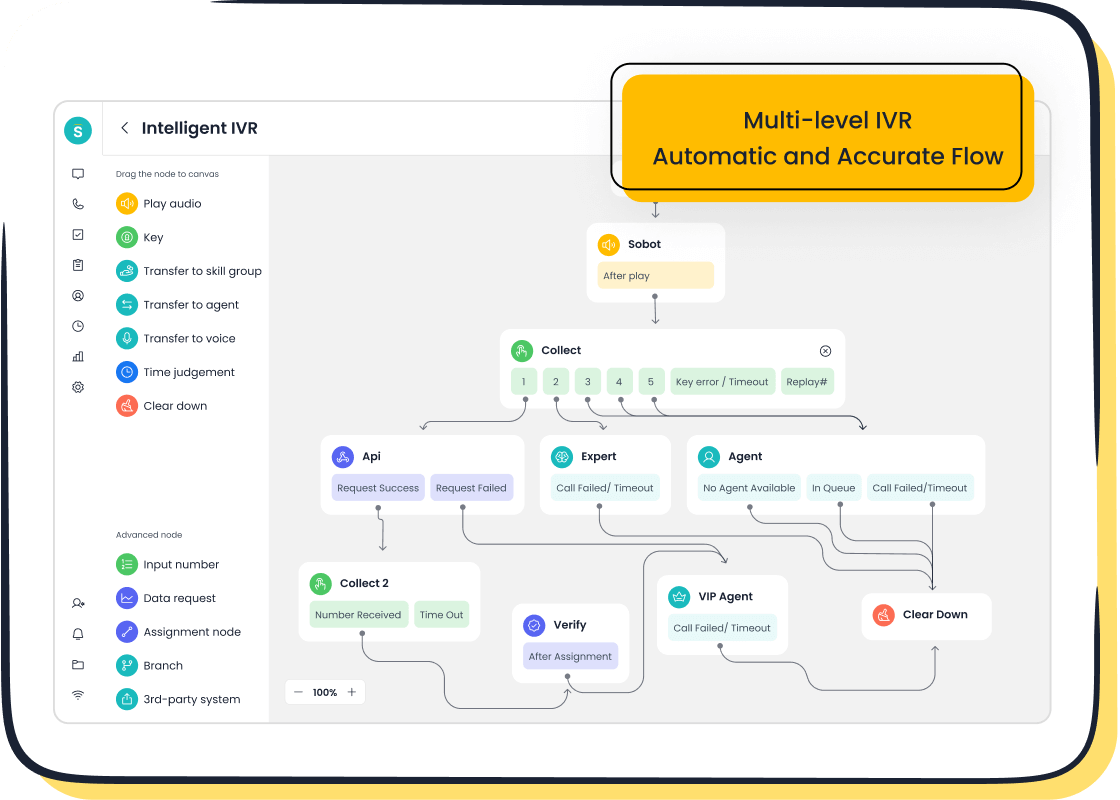
Sobot’s Voice/Call Center Features for Phone Support
Sobot’s Voice/Call Center is designed to overcome these challenges and elevate your phone customer support. Here’s how:
- AI-powered communication tools provide instant and accurate customer support.
- Advanced natural language processing enables nuanced interactions.
- Chatbots and voicebots handle routine queries, freeing human agents for complex issues.
- Virtual assistant systems improve over time, enhancing overall service quality.
Sobot also ensures continuous support that transcends traditional business hours. Customers can receive immediate assistance anytime, anywhere. With features like intelligent IVR, smart call routing, and global number availability, Sobot’s solution is built for efficiency and reliability.
If you’re looking to enhance your phone customer service, Sobot’s Voice/Call Center is a game-changer. Learn more about its features here.
Social Media Customer Service: Pros and Cons
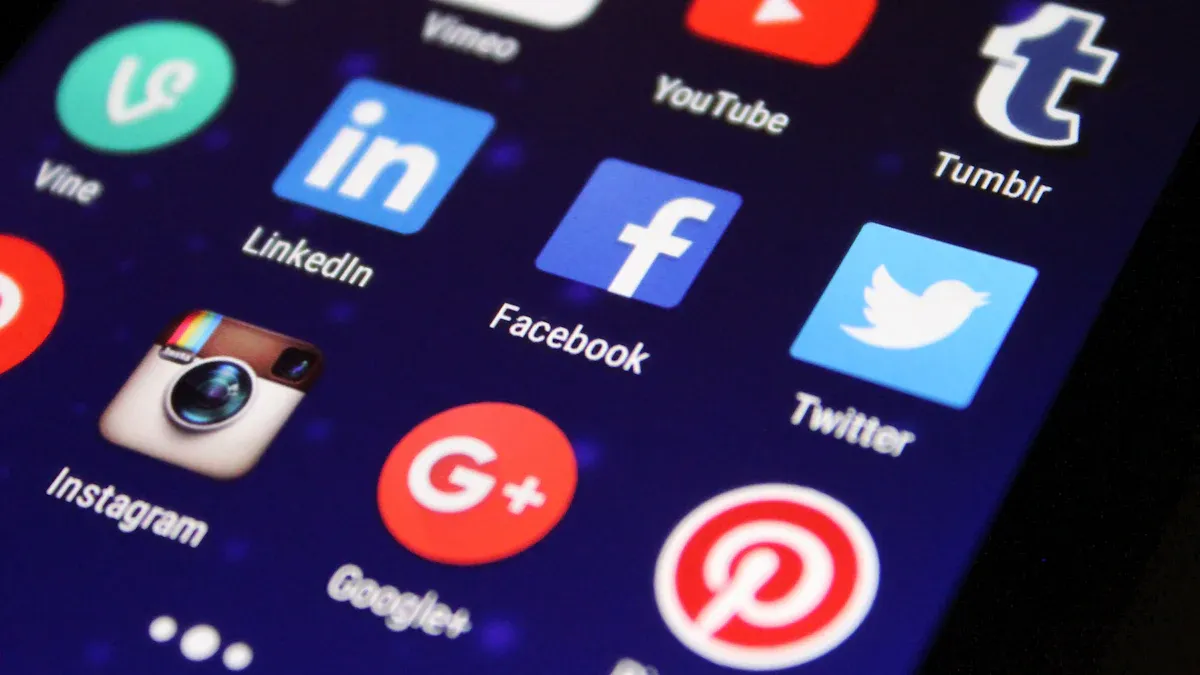
Advantages of Social Media Customer Service
Social media has transformed how businesses interact with customers. It’s fast, accessible, and incredibly effective for building relationships. You can engage with your audience in real time, which is a game-changer for customer support.
Here’s why social media customer service stands out:
- Customers expect instant responses due to the immediacy of social media.
- There’s a growing demand for quick resolutions to customer queries.
- Brands are anticipated to be available 24/7, meeting modern expectations.
Social media also gives you valuable insights into customer behavior. By analyzing comments, likes, and shares, you can understand what your audience wants. This helps you improve your products and services. Plus, it’s a great way to enhance brand management and customer service.
| Pros |
|---|
| Content optimization |
| Insights into customer behavior |
| Product development |
| Customer service enhancement |
| Brand management |
Challenges of Social Media Customer Service
While social media offers many benefits, it’s not without its disadvantages. One major challenge is data privacy. Customers share personal information online, and protecting that data is crucial.
Another issue is siloed data. If your social media platforms don’t integrate with your other customer support tools, it can lead to inefficiencies. Cultural challenges also arise when managing a global audience. Misunderstandings can occur if your team isn’t familiar with local customs or languages.
| Cons |
|---|
| Data privacy |
| Siloed data |
| Data accuracy |
| Resource-intensive |
| Cultural challenges |
To overcome these hurdles, you need a robust omnichannel solution like Sobot. It integrates social media with other types of customer service, ensuring seamless communication and better data management.
Leveraging Social Media for Brand Visibility
Social media isn’t just about customer support—it’s a powerful tool for boosting your brand’s visibility. Successful campaigns can turn your business into a household name.
| Brand | Campaign/Strategy | Description |
|---|---|---|
| Nike | #justdoit Campaign | A successful campaign that encourages people to pursue their goals, utilizing influencer marketing. |
| Wendy's | Twitter Engagement | Known for witty responses, Wendy's engages its audience with entertaining content, building a large following. |
| Airbnb | Instagram Campaigns | Focuses on unique properties and experiences, using high-quality visuals to appeal to travelers. |
You can follow these examples to create engaging content that resonates with your audience. With Sobot’s omnichannel solution, you can manage all your social media interactions in one place. This makes it easier to respond quickly, track performance, and build a loyal community around your brand.
Self-Service Options: Pros and Cons
Benefits of Self-Service Customer Support
Self-service options are a game-changer in customer service. They empower customers to find answers on their own, saving time for both parties. Imagine having access to a self-service knowledge base that’s available 24/7. Whether it’s midnight or a busy afternoon, you can get the help you need without waiting for an agent. This convenience is why 77% of people prefer self-service portals over contacting support.
Another big win? It reduces the workload for your customer support team. With fewer tickets to handle, agents can focus on more complex issues. Plus, self-service tools like multilingual knowledge hubs make it easier to serve international audiences. Businesses also see a boost in customer satisfaction, with 79% of consumers saying they’re more likely to buy again after a positive experience.
| Pros |
|---|
| 24/7 availability to customers |
| Customer support ticket volume is reduced significantly |
| Ability to build a multilingual resource hub to serve global audiences |
| Customer support operators can focus on other issues |
Challenges of Self-Service Customer Support
While self-service is incredibly useful, it’s not without its challenges. For starters, not everyone finds it easy to navigate. Older customers or those unfamiliar with technology might struggle to use a self-service knowledge base. This can lead to frustration instead of satisfaction.
Another hurdle is keeping the resource up-to-date. A self-service portal needs constant updates to stay relevant. If it doesn’t address all customer queries, it risks leaving users dissatisfied. And let’s face it, no system can answer every single question. That’s why having a backup plan, like chatbot customer support, is essential.
| Cons |
|---|
| Not all customers (e.g., elderly) can understand the mechanism |
| A self-service resource should be constantly updated |
| It could be impossible to provide answers to all customer requests |
Sobot’s AI-Powered Chatbot for Self-Service Solutions
Sobot’s AI-powered chatbot takes self-service to the next level. It’s like having a virtual assistant that’s always ready to help. The chatbot is multilingual, making it perfect for businesses with a global audience. It uses advanced AI to understand customer intent, providing accurate answers in seconds. This reduces the need for human intervention and speeds up resolutions.
What sets Sobot apart is its seamless integration with other types of customer service. Whether it’s live chat, email, or phone support, Sobot ensures a smooth transition if a customer needs more help. The chatbot also learns over time, improving its responses and making your self-service portal smarter.
Here’s a quick look at why self-service is so effective:
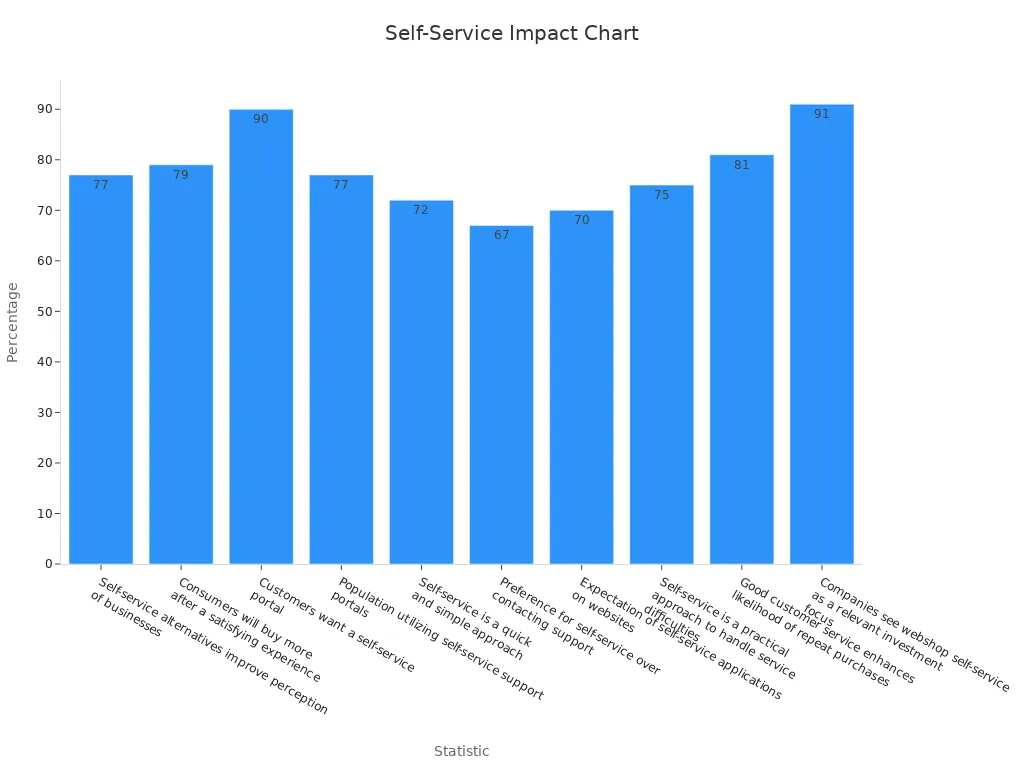
With Sobot’s chatbot customer service, you’re not just meeting customer expectations—you’re exceeding them. It’s a practical, efficient, and scalable solution for modern businesses.
Customer Support Outsourcing: Pros and Cons
Outsourcing customer support has become a popular choice for businesses looking to streamline operations and improve efficiency. But like any strategy, it comes with its own set of pros and cons. Let’s dive into what makes customer support outsourcing a game-changer—and where it might fall short.
Advantages of Outsourcing Customer Support
Outsourcing offers several benefits that can transform how you handle customer service. Here’s a quick breakdown:
| Advantages | Description |
|---|---|
| Cost savings | Outsourcing reduces overhead costs by leveraging third-party infrastructure. |
| 24/7 availability | Customers get round-the-clock support, improving satisfaction. |
| Access to technology | Vendors provide advanced tools and systems without extra investment. |
| Improved business performance | Faster response times and resolutions boost operational efficiency. |
| Flexibility in scaling operations | Easily adjust support levels during peak seasons or growth phases. |
| Access to specialized expertise | Trained professionals handle customer queries with precision. |
For example, many businesses report saving time and money by outsourcing customer care operations. Third-party vendors often bring expert personnel and infrastructure, allowing you to focus on core business functions.
Disadvantages of Outsourcing Customer Support
While outsourcing has its perks, it’s not without challenges. Here’s what you need to watch out for:
| Disadvantages | Description |
|---|---|
| Brand disconnection | Outsourced agents may lack deep knowledge of your brand. |
| Communication barriers | Language or cultural differences can lead to misunderstandings. |
| Over-dependence on service providers | Relying too much on vendors can reduce your control over operations. |
| Potential security risks | Sharing sensitive data with third parties increases vulnerability. |
| Minimal quality control | Ensuring consistent service quality can be tricky with external teams. |
For instance, outsourcing can sometimes lead to a loss of decision-making authority. If the vendor doesn’t align with your expectations, it could result in quality issues or reputational damage.
Tips for Effective Outsourcing Strategies
To make the most of customer support outsourcing, you need a solid plan. Here are some tips to ensure success:
- Choose the right partner: Look for vendors with domain expertise and a strong market reputation.
- Prioritize communication: Set up multiple channels for regular updates and feedback.
- Focus on data security: Ensure your partner complies with regulations like GDPR to protect customer information.
- Integrate technology: Use tools like Sobot’s omnichannel solutions to streamline workflows and improve efficiency.
- Adapt to change: Build flexible systems that can scale with your business needs.
By following these strategies, you can overcome common outsourcing challenges and deliver exceptional customer service. Remember, the key is to maintain a balance between cost efficiency and quality.
Choosing the right customer service type can make or break your customer experience. Each option has its strengths and weaknesses. For instance, phone support excels at solving complex issues quickly, while live chat offers convenience and multitasking. Email provides detailed communication, but it can be slower. Social media is great for engagement but requires careful reputation management. Self-service tools empower customers but need regular updates to stay effective.
To succeed, align your customer service strategy with your business goals and audience preferences. If your customers value speed, live chat or social media might be ideal. For industries requiring detailed explanations, email or phone support could be better. Tools like Sobot’s omnichannel solutions can help you integrate multiple channels seamlessly, ensuring you meet diverse customer needs while boosting efficiency.
FAQ
What is the best type of customer service for small businesses?
It depends on your audience. Live chat works well for quick responses, while email suits detailed queries. For cost-effective solutions, self-service options like Sobot’s AI-powered chatbot can reduce workload and improve efficiency. Small businesses often benefit from combining multiple channels to meet diverse customer needs.
How can I measure the success of my customer service strategy?
Track metrics like customer satisfaction (CSAT), resolution time, and Net Promoter Score (NPS). Tools like Sobot’s omnichannel solution provide analytics to monitor performance. For example, a high NPS indicates loyal customers, while reduced resolution time shows improved efficiency.
Why is omnichannel customer service important?
Omnichannel service ensures seamless communication across platforms like email, social media, and phone. Customers expect consistent experiences. Sobot’s unified workspace integrates all channels, helping you deliver personalized support and boost satisfaction by up to 30%.
Can self-service options replace human agents?
Not entirely. Self-service tools like Sobot’s chatbot handle repetitive queries efficiently, but complex issues still need human expertise. Combining both ensures faster resolutions and better customer experiences.
How does Sobot ensure data security in customer interactions?
Sobot uses encrypted data transfer and complies with global regulations like GDPR. Its 99.99% system uptime ensures reliable and secure operations, giving you peace of mind while managing customer interactions.
See Also
10 Strategies for Selecting Social Media Support Tools
10 Ways to Enhance Live Chat Customer Experience
2024's Leading Customer Service Software Solutions Revealed
Comparative Analysis of Leading Voice of Customer Tools
Essential QMS Guidelines for Effective Call Center Operations
